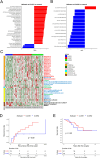Multiomics Analysis of Liver Molecular Dysregulation Leading to Nonviral-Related Hepatocellular Carcinoma Development
- PMID: 39982271
- PMCID: PMC11894656
- DOI: 10.1021/acs.jproteome.4c00729
Multiomics Analysis of Liver Molecular Dysregulation Leading to Nonviral-Related Hepatocellular Carcinoma Development
Abstract
Chronic liver diseases exhibit diverse backgrounds, and it is believed that numerous factors contribute to progression to cancer. To achieve effective prevention of nonviral hepatocellular carcinoma, it is imperative to identify fundamental molecular abnormalities at the patient level. Utilizing cancer-adjacent liver tissues obtained from hepatocellular carcinoma patients (chronic liver disease), we conducted RNA-Seq and metabolome analyses. In the chronic liver disease cohort, upregulation of inflammation-associated signals was observed, concomitant with accumulation of acylcarnitine and fatty acid and depletion of NADP+, gamma-tocopherol, and dehydroisoandrosterone-3-sulfate-1 (DHEAS). To minimize heterogeneity, we performed multiomics clustering, successfully categorizing the chronic liver disease cases into two distinct subtypes. Subtype 1 demonstrated elevated inflammatory levels, whereas Subtype 2 included a disproportionately high proportion of elderly cases. Furthermore, RNA-Seq analysis revealed upregulation of inflammatory signals in Subtype 1, while both subtypes exhibited downregulation of fatty acid metabolism. Metabolome analysis indicated a tendency of increased acylcarnitine levels in Subtype 1 and augmented fatty acid accumulation in Subtype 2. Validation of differentially expressed genes using the Gene Expression Omnibus (GEO) data set revealed the potential for amelioration through supplementation with antioxidants such as epigallocatechin gallate (EGCG).
Keywords: MOVICS; NAD metabolism; NAFLD; acylcarnitine; fatty acid.
Conflict of interest statement
The authors declare no competing financial interest.
Figures






References
-
- Nagaoki Y.; Hyogo H.; Ando Y.; Kosaka Y.; Uchikawa S.; Nishida Y.; Teraoka Y.; Morio K.; Fujino H.; Ono A. Increasing incidence of non-HBV- and non-HCV-related hepatocellular carcinoma: Single-institution 20-year study. BMC Gastroenterol. 2021, 21 (1), 306.10.1186/s12876-021-01884-5. - DOI - PMC - PubMed
-
- Tokushige K.; Hashimoto E.; Horie Y.; Taniai M.; Higuchi S. Hepatocellular carcinoma in Japanese patients with nonalcoholic fatty liver disease, alcoholic liver disease, and chronic liver disease of unknown etiology: Report of the nationwide survey. J. Gastroenterol. 2011, 46 (10), 1230–1237. 10.1007/s00535-011-0431-9. - DOI - PubMed
-
- Enomoto H.; Ueno Y.; Hiasa Y.; Nishikawa H.; Hige S.; Takikawa Y.; Taniai M.; Ishikawa T.; Yasui K.; Takaki A. The transition in the etiologies of hepatocellular carcinoma-complicated liver cirrhosis in a nationwide survey of Japan. J. Gastroenterol. 2021, 56 (2), 158–167. 10.1007/s00535-020-01748-x. - DOI - PMC - PubMed
MeSH terms
Substances
LinkOut - more resources
Full Text Sources
Medical

